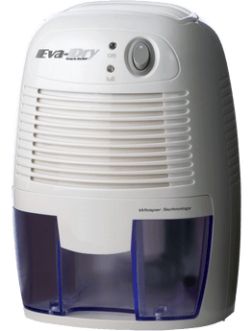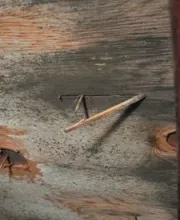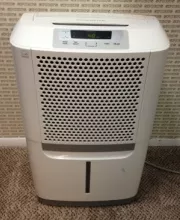Find a Mold Specialist Now
Click or Call, Toll-Free 24/7
Dehumidifiers For Bathrooms
Do you need a dehumidifier for bathroom areas of your home? Like all dehumidifiers, bathroom dehumidifiers are used to reduce humidity in the room. High relative humidity, greater than 60 percent according to the U.S. Environmental Protection Agency (EPA), is associated with mold in the home and as you may know, household mold has been linked to all sorts of problems. We'll tell you just what is so bad about bathroom mold and about the best way to prevent it.
Why Is Bathroom Mold a Problem?
It may seem obvious that homeowners would want to avoid mold in their bathrooms. After all, mold is unsightly and gives a bathroom the appearance of not being cleaned in a long while. It also gives your bathroom an unpleasant odor. Those are the least of the problems related to bathroom mold, however.
You're probably aware that exposure to household mold has been linked to numerous health problems, including respiratory infections, asthma, and allergic reactions. Did you know that some mold-related health problems are long-lasting or chronic, continuing long after people are no longer exposed to mold? Here is more about mold-related health problems.
Mold can also cause significant damage to your home. It literally eats away at organic materials like wood and can destroy walls, ceilings, and floors. Follow this link to learn more about how mold damages your home.
Mold grows rapidly and spreads easily, so mold that starts out in your bathroom can eventually find its way to your entire home. Mold remediation is a time-consuming and costly undertaking, so it is definitely worth the effort required to prevent mold from beginning to grow in the first place.
Do You Need a Dehumidifier for Bathroom Areas?
Bathrooms are naturally warm, moist places, ideal for mold. Bathwater may splash on the floor and a hot shower steams up the whole bathroom. There are also plenty of pipes that may drip or leak.
In addition, bathrooms are often poorly ventilated. Many bathrooms have no windows, there is usually only one door, and that door may be closed much of the time. The lack of ventilation increases the likelihood of mold in bathrooms.
If you have an exhaust fan in the bathroom, turning it on every time you shower will reduce moisture in the air and lessen the need for a dehumidifier. If you don't have an exhaust fan, though, or if you’ve discovered mold despite using an exhaust fan, you may want to consider a dehumidifier.
Preventing Bathroom Mold
In addition to using a dehumidifier for bathroom areas, there are other things you can do to reduce the risk of mold your bathroom.
 Shower with exaust fan/light
Shower with exaust fan/light- Don't use carpeting in bathrooms. Use tile or linoleum on floors instead and add throw rugs for softness and warmth.
- Hang up throw rugs to dry if they get damp.
- Wipe up any spilled water right away.
- Squeegee the shower walls so they dry faster.
- Make sure the shower curtain is pulled closed when you shower, to keep the floor dry. If the floor does get wet, dry it right away.
- After showering, spread the shower curtain out on the rod so it can dry faster. If you have a shower door instead of a curtain, leave the door open a few inches to increase ventilation inside the shower, so the walls will dry faster.
- Turn on the exhaust fan when showering, if you have one. Leave it on until all the steam in the room has dissipated. If you don't have an exhaust fan, open a window a few inches if you have a window in your bathroom.
- If you don't have an exhaust fan in the bathroom, consider installing one. An exhaust fan really does go a long way toward increasing ventilation and preventing mold.
- Leave the bathroom door open after showering to increase ventilation in the bathroom. If you live alone, you might want to leave it open a few inches while showering.
- Clean your bathroom with a disinfectant with antifungal properties to kill any mold that begins to grow.
- Repair any leaky faucets or pipes as soon as possible.
- Check for leaks regularly under the sink and behind the toilet. Placing leak sensors under your sinks is an easy way to prevent a small leak from becoming a big problem.
Even if you do all of these things, you may need a dehumidifier to prevent mold in the bathroom, especially if the ventilation in your bathroom is poor or if your bathroom is prone to mold for some reason. And even if you have a good dehumidifier in your bathroom, these are still useful tips to help prevent mold in your bathroom. While a dehumidifier is a good defense against mold, it isn't always enough by itself.
Selecting a Dehumidifier for Bathroom Areas
When selecting a dehumidifier, you need to consider both the size of the area in which it will be used and how damp that area is. Bathrooms are pretty damp, but even a large-sized bathroom is a small area. You won't need a large dehumidifier. Follow this link for a helpful chart you can use to assist you in choosing the right size.
Most bathroom dehumidifiers are compact and don’t hold much water, so you may need to empty them every week or so. All dehumidifiers automatically shut off when they are full so that they do not over-flow.

Our Favorite Bathroom Dehumidifiers
Our favorite dehumidifier for bathrooms is the Eva-dry EDV-1100. Eva-dry only makes small dehumidifiers, several of which are ideal for use in a bathroom. They are available with a variety of features, including some that use a renewable silica gel technology so that the dehumidifier does not need to be plugged in or use batteries. Many carry the Energy Star rating, which means they operate as efficiently as possible, benefiting both the planet and your pocketbook. Follow this link to learn more about the Eva-dry EDV-1100 and to read reviews from people that own one.
Return From Dehumidifier For Bathroom To Our Main Dehumidifier Page
Privacy Policy Terms and Conditions Accessibility Do Not Sell My Information Disclaimer Contact Us




